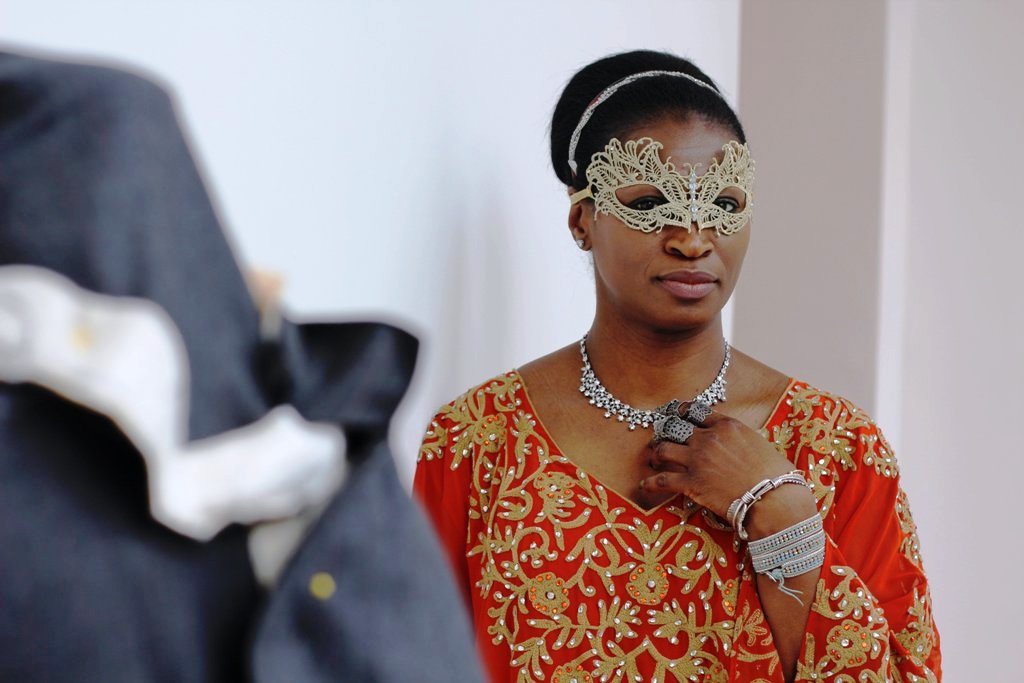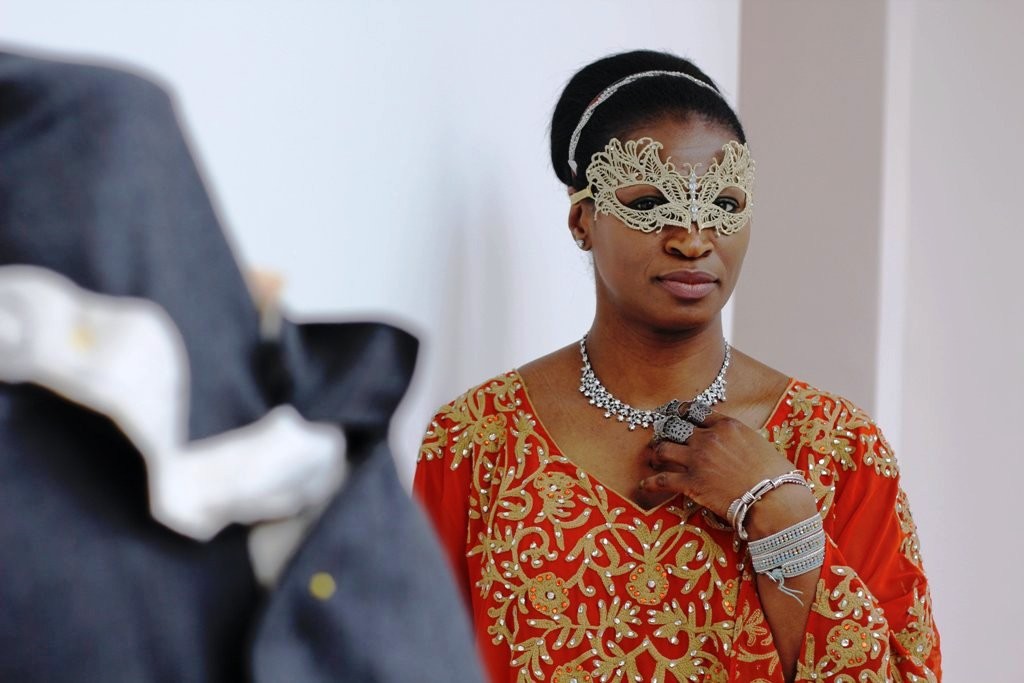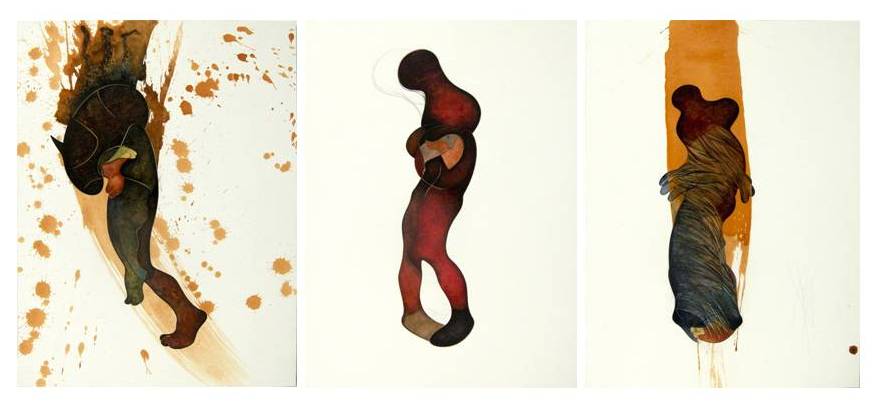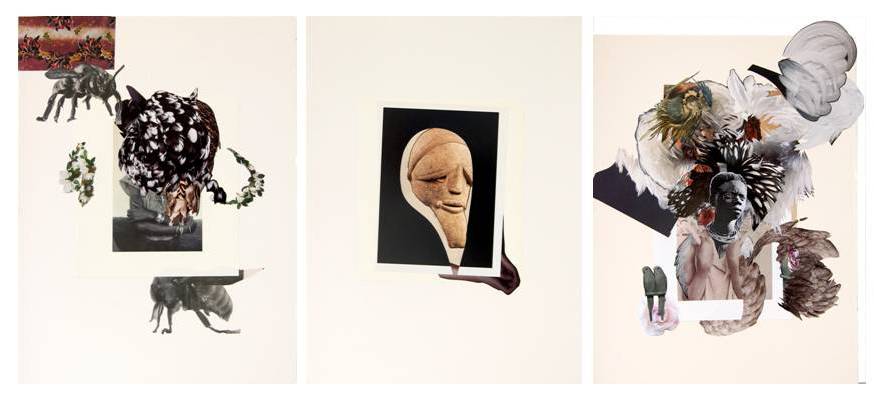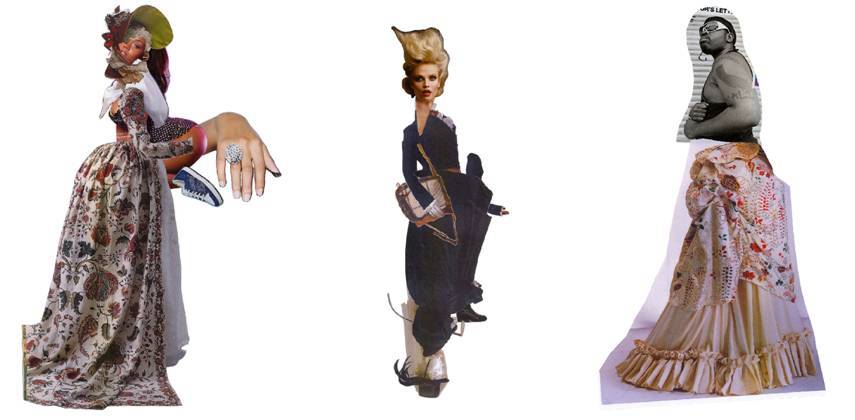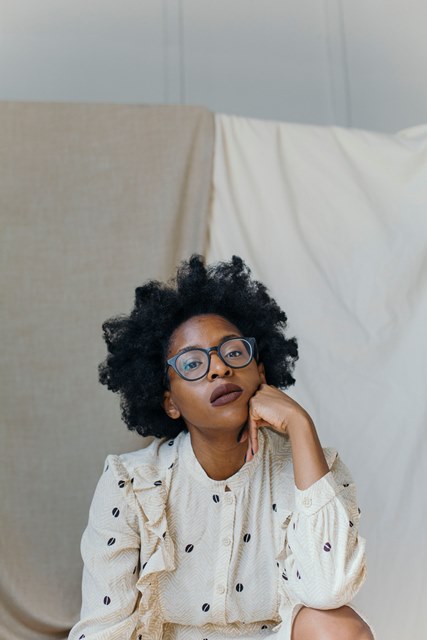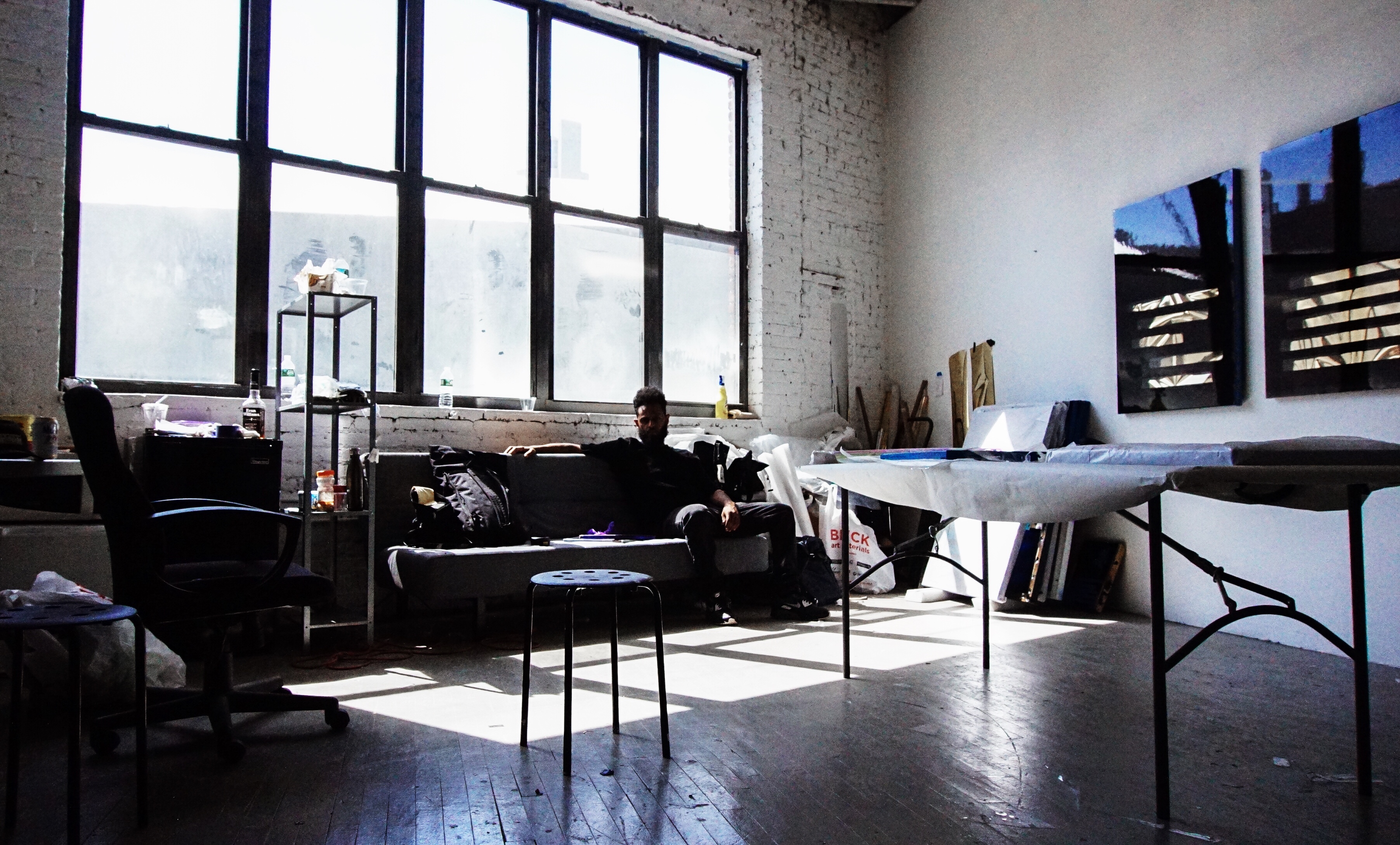Nigerian born artist Marcia Kure’s work is a sensuous, earth toned exploration of motion, texture, and tension. Her paintings and sculptures feature layers of fabric and patterns that drape amorphous, faceless, figures — simultaneously exposing and concealing physical forms, creating an intriguing mystery. Marcia’s work has been featured in Vogue, as well as many group shows and solo exhibitions, most notably those at the Susan Inglett Gallery in New York. Marcia sat down with AMMO to discuss what intrigues her about body language, Uli style painting, and her upcoming exhibit about Alexander McQueen’s influence on her development as an artist.
AMMO: What is your AMMO?
MARCIA KURE: Opposing and contradicting forces, things that repel yet attract one another. This forged, fused, and forced union — the kind of union that yields similar traits and sometimes it yields contradictions. I’m not really interested in the things that have a fixed or defined position or definition. I am more interested in things that are constantly shifting, things that defy categorization, it’s not really a question of what I can use to position or frame my paintings, but more about the places in between, the grey areas if you will, the negative spaces. That is my AMMO.
A: Speaking with Christine Eyene last year at the Contemporary African Art Fair, you stated that in your work ‘Cloth becomes body, body becomes cloth.’ When did you begin this exploration of the body, and by extension of that, the exploration of fabric and fashion?
MK: My first painting was of a woman draped in cloth. The image looked stoic, statuesque, the face was black. I became really interested in what the body does to cloth, and what cloth does to the body. Not so much so as what the facial features were trying to express, but more about what the body was trying to say. Another kind of language as it were, another way of speaking. Around this time I was introduced to Uli, body and mural painting. Uli painting and drawing is practiced by the people of Southeastern Nigeria; it’s a form of pictograms drawn on the body, they adorn the body, veil the body, and provide another layer to the body. When I moved to the United States I was introduced to fashion designers that touched upon this communication with cloth. I was attracted to designs they used, they had a kind of conceptual feeling to their practice. They pushed clothing to the boundaries of what dress really meant and what the body does to dress. Exploration of this has lead me to create large sculptural installations, it is more about the material being the fusion of cloth and body. The material itself becomes the body and takes on different aspects of making a garment — stitching, sewing, mending broken parts of the structure. Trying to heal, like a surgeon.
A: In many of your paintings, collages, and sculptures there is a strong emphasis on how fabric creates form. Though physically formed in detail many of your figures have no faces or eyes, they are often obstructed by fabric or hidden entirely in darkness. Why do you create this obstruction?
MK: There is something attractive something uncomfortable in what we can not see. It creates a certain kind of tension. That thing that is not unveiled becomes a thing of curiosity or interest, it adds a certain kind of talk or force within the drawing. There is something disturbing about having a veiled or concealed figure, it also goes back to that whole idea of the body being another kind of language. The contorted body, for example, speaks volumes and gives the figure of the drawing a kind of force that I am drawn to. It picks up from surrealism, specifically Rene Magritte’s painting of the figure with the apple. Some part of the face is revealed, but not everything, the whole question is why? I am drawn to what else the body says.
A: Even when you are not working specifically in the medium of collage, your drawings and sculptures convey layers, textures, and dimensions — can you explain what intrigues you about those elements of design?
MK: When I paint, when I create my colors, I create them in very subtle layers; the technique is called glazing. Where each layer, doesn’t obliterate the layer before it rather it enhances it, makes it more complex and gives it more meaning. I’ve taken that same process of glazing, and layering onto the collages, but it’s a different medium. It reacts to that same process differently. The paper that was laid before the one on top creates impressions. These impressions, these layerings are like the internal struggles of the human condition. They speak to the idea of just being human, about what we’re trying to conceal. The problem is that we try to hide it with happiness, there is shame that becomes like clothing piled up on one another, concealing. There’s an attraction to this kind of dimension, especially the way that collage does does it. Collage is a particularly interesting medium, it lends itself so well to things that are forged first — everything becomes compressed. The tension of the lines, the fusion of one part that is quite alien to another part. All of a sudden, the mind or the eyes are forced to make a connection between the two.
A: When you first moved to New York, what was the biggest adjustment you had to make?
MK: Before I came to New York I had traveled quite a bit and I’d had two shows in the US already, so it wasn’t really the kind of shock you would expect to get when you encounter a culture for the first time. I would say I was eased into it, so it was that kind of interaction that I had with New York as something I was familiar with. The cold though! I remember when we had those huge snow storms last year, and every day I would open my door and think “You are an African! What are you doing here?!?” It was REALLY cold, in fact I don’t think I will ever get used to that!
A: You seem to travel frequently — how do you stay connected with your roots when you are far from home?
MK: For me it’s something I carry with me all the time, I have never really felt separated from home in that sense, where there is a disassociation. With me all the time seems to be that knowledge and aspects of my upbringing, I seem to have very strong connections. Sometimes I struggle with certain things that are not the way I am used to seeing them, but they are just done in a different way. I have trained my eye to such a place where I can make the connections and see home in different situations no matter where I am in the world. When it comes down to it there are certain smells or certain foods, things like that you miss, but I settled into the fact that there were new experiences that added to whatever it was that I brought from home. Only making my understanding of who I am and where I come from, and the kind of interactions that I was making become much more richer and interesting. It offered me a new perspective and I have managed to mind that and I have managed to come to terms with it, where it becomes more of a tool than a disadvantage. Especially in today’s world where you don’t have to be in a fixed location to know what’s happening there. I know what’s happening in Nigeria, sometimes before people in Nigeria.
A: You studied painting and sculpture at the University of Nigeria and continue to work in an adapted style of the Nigerian watercolor technique known as Uli. What is it about Uli painting that appeals to you?
MK: There are certain things about Uli that interest me on a deeper level than just painting, that interest me as a person. The way Uli scripts are drawn, they’re very poetic, biomorphic, feminine if you will. One of the tenants is simplicity of form, so it’s not too complicated or too crowded. There is a use of positive and negative space, and the color pallet is quite muted, and there is just a way and method it. It is a painting style that emphasizes the feminine and community. What really rocks my boat about Uli, is it’s a drawing and a painting tradition done predominantly by women. Groups of women come together and paint on one another’s body and paint murals on the wall, grind their paints, and create this wonderful imagery around the community. There is also another part of it, that ties quite well with different Western art movements that appeal to me like minimalism. So I am trying to use a restricted pallet, trying to reduce something to it’s bare essence.
A: Are there other techniques or styles that you learned at the University of Nigeria that you haven’t seen used in many other places?
MK: I think it’s more of the similarities, of what I studied and what I am experiencing now. It’s more about access to certain materials that I might have and somebody here might not have, or somebody here might have and I don’t have. In essence we’re all saying the same thing, but we’re saying it in different ways. We might be expressing the same kind of anxiety, we might have a different name for it, but we’re all really talking about being human. We’re talking about the same thing, just in different ways.
A: What upcoming projects can we look forward to seeing from you?
MK: We have a new project here at the Susan Inglett Gallery with the 154 Art Fair, a contemporary African art fair that is coming to New York for the first time. We’re really excited about that, it will be an artist led tour. There is an exhibition coming up in London in the Summer, called Alex and Me — in this show my aim is to explore the relationship between Alexander McQueen’s work and mine, how his practice has influenced mine and how they’re similar; there will be paintings, sculptures, and installations. I am drawn to his practice because of his reference to reference tradition, as well as patterns and sewing. The fundamentals of what makes clothing and dress what it is, his cut is precise because he has taken the time to study his craft, to break it down to deconstruct it and reconstruct it again. For me I have done something similar with drawing, both of us talk about the human condition and what it means to be human. So my intention is to explore this.
For more on the artist Marcia Kure and the Susan Inglett Gallery in NYC go to www.inglettgallery.com.
All of the images of the artists’ work courtesy of the Susan Inglett Gallery.
All images of Marcia Kure by Ashley Sky Walker.



